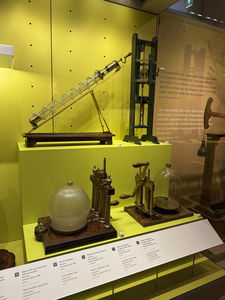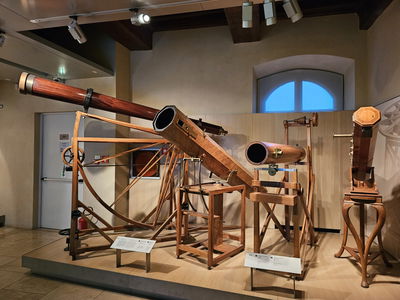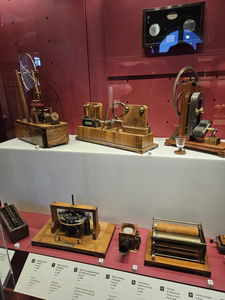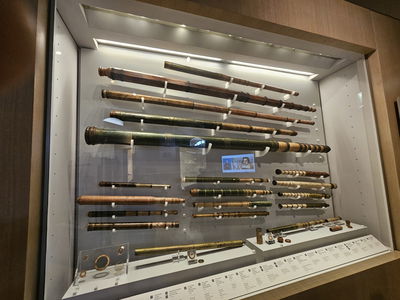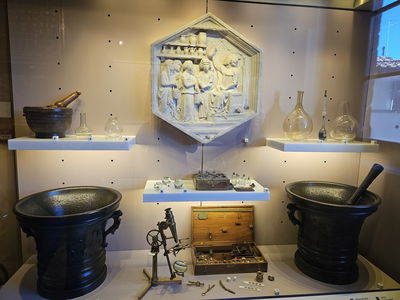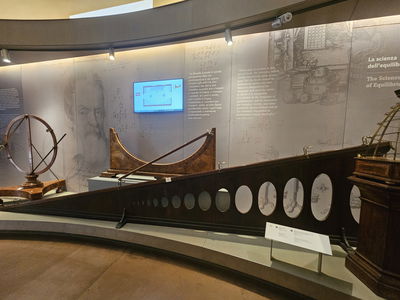Tucked beside the Arno River, just steps from the Uffizi Gallery, the Museo Galileo is a fascinating reminder that Florence’s genius wasn’t limited to art.
Housed in the medieval Palazzo Castellani, Stefano and I went on a guided morning visit to the museum and it turned out to be one of the most surprising and rewarding places we've visited recently. It is a space that celebrates the scientific spirit that flourished alongside Michelangelo and Botticelli, paying special tribute to Galileo Galilei, the Tuscan astronomer and first true modern scientist who changed the way we see the universe.
 Some displays are created for tactile visitors, which means you can touch! This one displays the problem at the center of Galileo's problems with the Catholic Church
Some displays are created for tactile visitors, which means you can touch! This one displays the problem at the center of Galileo's problems with the Catholic ChurchWe soon discovered that the museum holds one of the world’s major collections of scientific instruments, from about the 11th century up to the 19th century, all collected by the Medici and the Lorraine Grand Dukes of Tuscany. I am not a big science person, but even I soon realized that the collection is extraordinary: it includes instruments that were once used to explore the heavens, measure time (day and night), and understand the natural world, plus a bunch of other cool things.
Exploring the Galleries
Walking through each of the museum's galleries felt like traveling back in time. One of the main highlights in the museum is Galileo’s own telescopes - imagine him looking through those very lens and discovering Jupiter’s moons! But that's not the start of the museum collections, so let's backtrack first.
The collections are divided into the first floor holding the collections of the Medici and then the second floor the collections of the Lorraine dynasty, so in a way it is a map through time and the scientific instruments as they were being used chronologically. It was really neat to discover concepts we all learn in school, from optics to observing the sky to tell time to thermometers to electricity, and the tools that were invented and used in real life.
The Medici Collections
The first room had a very cool portrait from 1593 of Charles III, Duke of Lorraine, on wood over slats and a mirror at the top of it reflected another portrait - of a lady, his daughter Christina of Lorraine and wife to Ferdinand I de' Medici - on the same frame, but upside down! Pretty nifty trick, so consider the society that delighted back then and now in these types of cool optical tricks to entertain their guests!
 Isn't this a nifty trick?
Isn't this a nifty trick?The next two or three rooms had some particularly striking tools that I admit I had never seen: some beautifully crafted astrolabes, sundials and "nocturnals" and these tools needed to be useful as well as pretty! I learned from our amazing guide Carmen that the astrolabes and nocturnals were a sort of calculator, pointed at the sky and moved around to make calculations that were incredibly important for navigating as well as for telling time at night, using the position of the stars in the sky.
If you're a science person, this likely is nothing new to you, and if you have kids, I think these tools could be very interesting for those learning science, especially in encouraging them to imagine a world with no electricity or machines where only your knowledge can assist you - and nifty tools like in these displays. These tools were used in medieval times, and the ones here were collected for their practical value as well as for the small masterpieces of artistry and beauty that they are.

 The nocturnal our guide Carmen is holding up is made out of wood to let you play around with the tool and understand how it would work
The nocturnal our guide Carmen is holding up is made out of wood to let you play around with the tool and understand how it would workThe Armillary sphere in the next room took my breath away. Known as "Santucci's Armillary Sphere", it turns out to be the largest one in the world! What is it, you ask? It is a representation in painted wood of the UNIVERSAL MACHINE as it was known in the late 1500s. The concepts of the universe then had been developed by Aristotle and perfected by Ptolemy with Earth depicted at the center of this universe. This recreation therefore has earth at the center, seven globes representing planets and the sun revolving around it — and the whole thing used to move! They circles rotated to show the movement of the planets around around Earth.
Since it was dismantled and moved several times over the centuries across various locations in Florence, who knows when it stopped working but know that it was started in 1588 and completed in just 5 years at the request of Ferdinand I de' Medici and it stands over 370cm high (over 12 feet) and 245cm wide... and then, I encourage you to go see it in person! I think you will also remain quite impressed by the size and the concepts it represents. Look for the image of Almighty God presiding over the Universe as well and for the territories displayed on Earth, considering the times when it was built ;-).
 This is just a view of the Armillary Sphere from afar, you need to go near and sneak looks inside to find lots of details, from the depictions of land masses on Earth to the celestial bodies and to the One that looks over everything
This is just a view of the Armillary Sphere from afar, you need to go near and sneak looks inside to find lots of details, from the depictions of land masses on Earth to the celestial bodies and to the One that looks over everythingThis room and the following ones have globes and early maps, some of them dating from before the discovery of the Americas. Standing in front of them, I found myself imagining what the world must have felt like when so much of it was still unknown, when blank oceans were filled with mythical creatures yet the edges of knowledge were vast and so much was already known! It is incredible to see what men knew of the world by then, and looking at these maps and how man created representations of the earth according to what explorers had discovered on their travels is nothing short of outstanding!
 This globe has the Gulf of Mexico and Mexico and lots of parts of the New World mapped out
This globe has the Gulf of Mexico and Mexico and lots of parts of the New World mapped out This map has Europe, Africa and large parts of Asia mapped out, nothing yet of the Americas
This map has Europe, Africa and large parts of Asia mapped out, nothing yet of the Americas Close up view of Europe... notice the view is upside down from what we are used to today? Can you find Italy on the map?
Close up view of Europe... notice the view is upside down from what we are used to today? Can you find Italy on the map?Consider the courage and curiosity that has shaped human understanding through the centuries and then apply these same forces to Galileo. Courage and curiosity were the major forces that drove discoveries that had until then not been considered before. Also consider that Isaac Newton, often heralded as one of our modern scientists, was born just a year after Galileo died. That was an extraordinary time for humanity's growth and progress!
 A compass was important during battles and exploration, and if needed, could also be used as a weapon
A compass was important during battles and exploration, and if needed, could also be used as a weaponThe Galileo Hall

Soon we arrived at a large hall dedicated to Galileo, and not just to his telescopes. Here, we found displays with other of his own instruments, as well as a display containing Galileo's finger - that was a surprise for me!! If you will recall, Galileo was tried and excommunicated by the Church for his scientific theories and the finger conserved here is his middle finger.... one has to wonder who chose to keep that finger and put it into a reliquary, was it done on purpose? :D In any case, it is both strange as well as unforgettable, one of those curiosities that is a bit macabre and yet, you can’t quite stop thinking about afterward. The hall also has displays of some of this other experiments, such as on velocity and gravity.
 Galileo's telescopes, ones he built to improve on and used to observe the stars of the Milky Way, the phases of Venus, the four largest satellites around Jupiter, the rings of Saturn and lunar craters.
Galileo's telescopes, ones he built to improve on and used to observe the stars of the Milky Way, the phases of Venus, the four largest satellites around Jupiter, the rings of Saturn and lunar craters. Here it is, the middle finger... remember he was deemed "heretical" and lived under house arrest after 1633 in Florence for his defense of the idea that the Sun could be at the center of the universe.
Here it is, the middle finger... remember he was deemed "heretical" and lived under house arrest after 1633 in Florence for his defense of the idea that the Sun could be at the center of the universe.The Lorraine Collections
The second floor is dedicated to the collections of the Lorraine family, who arrived in Florence and Tuscany in 1737 after the last of the Medici family, Gian Gastone, died without any descendants, and ruled Tuscany for over 100 years up until the country of Italy was formed. It is the second Lorraine Grand Duke, Peter Leopold, who loved living in Florence and continued the scientific collections of the Medici, particularly conducting his own chemical experiments and a fine desk on the second floor attests to this. We can also attribute to him the opening of one of the first science museums in Europe (La Specola, another great museum to visit with kids) as well as the opening of the Uffizi Gallery to the public.
 Peter Leopold's chemical experiment desk
Peter Leopold's chemical experiment deskSince Peter Leopold's biggest legacy in Tuscany was that culture and knowledge could be public goods, he also helped revitalize and create public hospitals and medical schools. The room with the desk above has several displays with terracotta recreations used in teaching medical students and midwives how to handle difficult situations in labor... so I am not including any photos of those terracotta figures here. I invite you, especially if you're in the medical field, to look at them closely during your visit and let us know how factual they are.
The following rooms are rich in many types of instruments, from a clockwork mechanism operating a mechanical writing hand, a plate with brass tubes that could create electric shocks and barometers, vacuums and some of the first electric motors.
 These brass tubes could create electric shocks and were used as entertainment at parties.
These brass tubes could create electric shocks and were used as entertainment at parties.What Makes the Museo Galileo Special

What I appreciated most was how clearly the museum connects these objects to the people and dynasties behind them, to the times of great exploration and discovery, as well as part of cultural prestige. The Medici family was certainly essential in fostering the artistic Renaissance in Florence, yet they were also important in supporting science. It was not just an intellectual pursuit but it was a part of Florence’s identity, and that story is told beautifully through well-written displays and multimedia presentations.
The museum also has a smartphone app to be used inside the museum, so that you can specifically request info on items as you reach them. The website's section on the collections also has a great deal of info found on the app, which you can browse either before or after your visit: https://www.museogalileo.it/it/collezioni.html
 Here, you can test - which ball falls faster? The one in a short, straight slope or the one on the arc?
Here, you can test - which ball falls faster? The one in a short, straight slope or the one on the arc?While it’s not a “hands-on” science center, there are interactive sections - especially in the “Measurement of Time” area - that help bring the concepts to life for curious visitors. We kept thinking we have to go back with our kids, our middle boy is 8 years old and is learning about Galileo at school at the moment and he'd certainly love some of these displays. The museum holds science workshops for kids (only in Italian) that cover many areas, from Galileo's telescopes, optics, the colors of light, the science of bubbles, air and vacuums, microscopes, exploration and several more. If interested, these can only be booked online on the official website and run on weekend afternoons between the end of November and mid-May.
 The bookshop has a lot of fun items and books, for kids and adults alike
The bookshop has a lot of fun items and books, for kids and adults alikeWho Should Visit

I'd recommend the Museo Galileo to anyone interested in the history of science, astronomy, or the Renaissance beyond painting and sculpture. I think it would be great for families with older children, students, and curious travelers who want to see another side of Renaissance genius.
Plan for about an hour or two for the full visit, and enjoy the quiet atmosphere of the museum before diving back into the bustle of central Florence and other museums.
Final Thoughts
 Look at how pretty this mini sundial was?
Look at how pretty this mini sundial was?For me, this museum was a wonderful reminder that Florence didn’t just shape how we see beauty: it shaped how we see the universe itself and it is an aspect of Florence we often forget when we are surrounded by so many artistic treasures! It is a great reminder of how human genius has worked, how our curiosity has worked overtime to figure out concepts that led to better understanding of our world. It was surprising to both myself and Stefano to see how much was already known and understood hundreds of years ago, without the use of many of the instruments we have today. And to realize, once again, that Florence really was, for quite a bit of time in our history, the "center of the world" as human progress was reborn after the "Dark Ages".
I invite you to go explore the Galileo Museum and let us know what parts of the collections you find the most enjoyable! I highly recommend you visit with a guide, either one offered by the museum (booking required) or with an independent guide as they will highlight which items are of particular note and the history tied to them. If you don't wish for a guide, make sure to download the "Museo Galileo" APP for the museum (Google Play or Apple Itunes) and use it during your visit.
